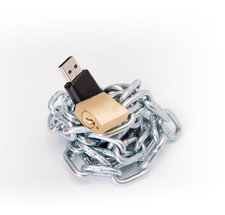Protecting your USB sticks with encryption
Atick Security

© Marcio Eugenio, 123rf.com
How easy is it to lose a USB stick? Why not protect your data just in case the stick falls into unfriendly hands?
Many users carry critical information around on USB sticks. The information on the stick might include passwords, email addresses, spreadsheets, and other confidential information. If the stick is lost, the data could fall into the wrong hands. In this article, I'll show you how to encrypt information stored on USB sticks.
Encryption takes the worries out of carrying around USB treasures. Thanks to the device mapper infrastructure introduced with kernel 2.6, Linux now lets you add a protective shield to a filesystem. The dm_crypt kernel module uses this approach to encapsulate filesystems in an encryption layer. To mount the partition or hard disk, you first need to remove the protection by entering the correct password (Figure 1).
[...]
Buy Linux Magazine
Subscribe to our Linux Newsletters
Find Linux and Open Source Jobs
Subscribe to our ADMIN Newsletters
Support Our Work
Linux Magazine content is made possible with support from readers like you. Please consider contributing when you’ve found an article to be beneficial.

News
-
Manjaro 26.0 Primary Desktop Environments Default to Wayland
If you want to stick with X.Org, you'll be limited to the desktop environments you can choose.
-
Mozilla Plans to AI-ify Firefox
With a new CEO in control, Mozilla is doubling down on a strategy of trust, all the while leaning into AI.
-
Gnome Says No to AI-Generated Extensions
If you're a developer wanting to create a new Gnome extension, you'd best set aside that AI code generator, because the extension team will have none of that.
-
Parrot OS Switches to KDE Plasma Desktop
Yet another distro is making the move to the KDE Plasma desktop.
-
TUXEDO Announces Gemini 17
TUXEDO Computers has released the fourth generation of its Gemini laptop with plenty of updates.
-
Two New Distros Adopt Enlightenment
MX Moksha and AV Linux 25 join ranks with Bodhi Linux and embrace the Enlightenment desktop.
-
Solus Linux 4.8 Removes Python 2
Solus Linux 4.8 has been released with the latest Linux kernel, updated desktops, and a key removal.
-
Zorin OS 18 Hits over a Million Downloads
If you doubt Linux isn't gaining popularity, you only have to look at Zorin OS's download numbers.
-
TUXEDO Computers Scraps Snapdragon X1E-Based Laptop
Due to issues with a Snapdragon CPU, TUXEDO Computers has cancelled its plans to release a laptop based on this elite hardware.
-
Debian Unleashes Debian Libre Live
Debian Libre Live keeps your machine free of proprietary software.

